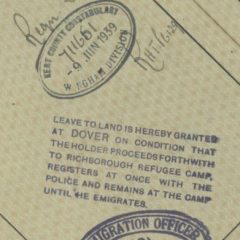When descendants get in touch with the project, it is notable how many people say at some point that they don’t have much information, that their fathers or grandfathers didn’t really talk very much about their time in the camp – or at all. People apologise for not knowing very much, or for not having very much material to send in.
First, then, a reassurance – this is normal. The most common situation, in fact, is that families have very small amounts of information at best, and that their relatives barely mentioned anything about this period of their lives.
In response, I try to reassure fellow descendants that this is what we expect – that this is normal – and that we still very much welcome the small pieces of information – or the one precious photograph, or the interesting document or letter, to add to this Kitchener camp project.
In other words, this was what we were expecting to be the case, so there is no surprise or disappointment at this end of things. Indeed, we have been overwhelmed at times by the stories and the items arriving. And deeply moved.
What I also try to highlight is that the point of the project in part is to gather together our many, many small pieces of information – and from these we may build a much larger picture of the camp and its context than has been available in the history to date.
And as we start to build up this project further over the coming weeks and months, then significant historical findings may start to come to light.
This evening, I have just looked up from my Excel spreadsheet and I wanted to share what I think I have discerned from the List of Names that has been quietly building in the background.
We have something in the region of 750 names at this stage – a little under that, but close. And what we thought we knew to date is that the age range for the camp ran from 17 to 40 – some stated it ran to age 45.
However … and a drum roll for Kitchener descendants everywhere, if you please … Even given these relatively few names so far – we have a 50-year old man, and a couple of others who are approaching that.
Every rule gets broken, eventually.
One lesson learned here is that digitised records can make a complete hash of reading original documents, because using digitised summaries in some instances, I initially believed we had people much older than this registered in the camp, but in fact it has been that the digitisation scans were incorrect. Always wait to see the originals …
It will be intriguing to see what else appears as these figures grow – and I hope we will find out much more about where the men came from (in terms of that perennial question of ‘why‘ people got a place), their Kitchener experiences, and about what they went on to do.
And at some point, of course, we will also be starting to explore the issue of the women and children who were in the camp. They haven’t been forgotten, but I need to take this one step at a time …
Anyway – that’s it for now. I’ll be back when I’ve done some more solid, archival work over the next few weeks.
……………………………………….
